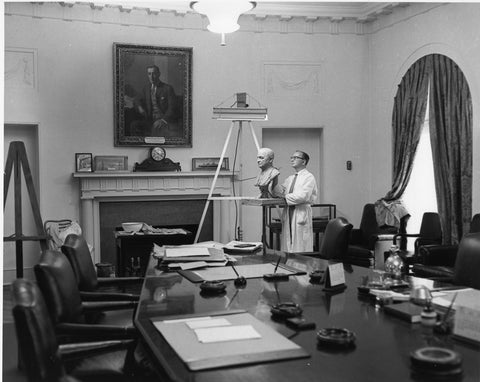Lindy Bank Of Lindbergh Charles Augustus, By Nison A. Tregor, 1928.
Lindy Bank Sculpted By Nison A. Tregor, Bust Of Lindbergh, Charles Augustus Aviator, Made Of Spelter a Zinc Alloy, By Grannis & Tolton In 1928, The Year After Charles Lindbergh Flew His Historic Solo Flight Across The Atlantic.
This Gilt Metal Bust Of Lindbergh Depicted In His Flight Cap with Goggles Made with Excellent Sculptural Detail. The Back Is Embossed "Lindy Bank © by G&T 1928" with a Signature By The Artist N. Tregor, Minor Finish Wear On The Gilt Finish, Bottom Cover Plate Missing.
A Terrific Piece Of American Aviation Memorabilia and a Nice Piece To Add To Your Bank Collection.
Nison A. Tregor (1904-1972)

Treger was born in Vilnius, the city that repeatedly changed hands between Poland, Lithuania, and the Soviet Union. Today, Vilnius is the capital of Lithuania.
Treger studied sculpture at Wilno University in Vilnius and Warsaw Academy of Fine Arts in Warsaw, Poland.
It was a chance encounter with Leo J. Kenna, the American Consul General in Warsaw, Poland, taking special interest in the young artist, Kenna helped Treger immigrate to the United States by writing a letter of recommendation to the U.S. Senator Henry Morgenthau. In 1922, he arrived in the United States to begin his education under famous sculptors Herman Atkins McNeil and Malvina Hoffman. In 1925, he decided to anglicize his name from “Treger” to “Tregor.” He became an American citizen upon marriage to his first wife Helen in 1931.
During the 1920s and 1930s, Tregor received commissions for sculpted portraits from many high-profile Americans including the Kennedy family. He modelled President Franklin D. Roosevelt at his home in Hyde Park, New York. The resulting bust was the first made of the President after his inauguration. Pleased with Tregor’s work, the Roosevelt Administration appointed him the unofficial sculptor. By the time the United States entered World War II, Tregor had sculpted the likenesses of General Douglas MacArthur, General Hugh Johnson, and the composer Ignace Paderewski.
Tregor enlisted in the U.S. Army Medical Corps in 1943. As a liaison officer at Walter Reed Hospital in Washington, D.C., he reconstructed in clay the shattered faces of soldiers to be used as models for plastic surgeons. His wealth of experience in sculpture, combined with his fluency in German, Russian, Polish, Czech, and Serbian, qualified Tregor for service with the MFAA. He was transferred to SHAEF, General Eisenhower’s headquarters, where he worked as an aide to General Walter Bedell Smith. In early 1945, Tregor was assigned to the headquarters of the 12th U.S. Army Group as an MFAA liaison officer with the Reparation, Deliveries, and Restitution Division of the U.S. Group Control Council. In addition, he was sent on many special assignments within the U.S. Zone of Occupation to advise on the rehabilitation and restitution of sculptures. In 1945, he delivered to the Wiesbaden Central Collecting Point Auguste Rodin‘s stolen bronze L’age d’ Airain as well as Champagne’s Portrait of a Young Man after it was found in the Berlin home of Joseph Goebbels. Tregor also interviewed Arno Breker, favourite sculptor of the Nazi Party, regarding the whereabouts of Nazi-looted art. The two men reportedly became friends.
At the end of the war, General Eisenhower posed for Tregor in a studio near Wiesbaden, Germany. Generals George C. Marshall, Omar Bradley, Walter Bedell Smith and George Patton soon followed. In 1947, rather than returning to the U.S., Tregor and his second wife Else travelled throughout South America accepting commissions from foreign patrons. In Argentina, he modelled the heads of Juan and Evita Peron. In Chile, he received a commission from President Gabriel Gonzales Videla.
In the following years, he travelled widely across Europe. Italy in 1951, Paris in 1956, and Monte Carlo in 1962. By the end of his career, he had modelled President Harry Truman, Winston Churchill, Henry Ford II, the Hollywood executive Jack Warner, and Greek shipping magnate Stavros Niarchos.
Nison Tregor died in Monte Carlo in 1972.
Lindbergh, Charles Augustus (1902-1974)

An American aviator made the first solo nonstop flight across the Atlantic Ocean on May 20-21, 1927. Other pilots had crossed the Atlantic before him. But Lindbergh was the first person to do it alone nonstop.
Before Japan attacked Pearl Harbor in 1941, Lindbergh campaigned against voluntary Americans in World War II. Many Americans criticized him for his beliefs. After the war, he avoided publicity until the late 1960s, when he spoke out for the conservation of natural resources. Lindbergh served as an adviser in the aviation industry from the days of wood and wire aeroplanes to supersonic jets.
Item Code - PIG7B261MAC
Width: 4" Height: 6 3/8" Depth: 3 1/4" Weight: 504 g



















